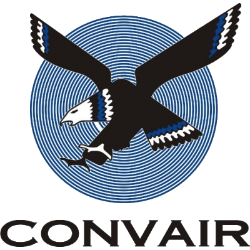Consolidated / Convair F-106 Delta Dart
Role Fighter interceptor
Manufacturer Convair
First flight 26 December 1956
Introduction June 1959
Retired August 1988 (ANG); 1998 (NASA)
Primary users United States Air Force
Air National Guard
Number built 342 (2 prototypes, 277 F-106A, 63 F-106B)
Developed from Convair F-102 Delta Dagger
.
History Consolidated / Convair
Convair F-106 Delta Dart

The Convair F-106 Delta Dart was an all-weather interceptor aircraft designed and produced by the American aircraft manufacturer Convair.
The F-106 was designed as the so-called "Ultimate Interceptor" as a consequence of the 1954 interceptor program of the early 1950s. It was a development of the F-102 Delta Dagger, and thus was originally designed as the F-102B prior to being redesignated by the United States Air Force (USAF).
The F-106 was gradually withdrawn from USAF service during the 1980s as the arrival of newer air superiority fighters, particularly the McDonnell Douglas F-15 Eagle, had made the role of dedicated interceptors increasingly redundant. Numerous F-106s would be operated for a time by the Air National Guard. Many withdrawn aircraft were promptly converted into target drones and redesignated QF-106 under the Pacer Six program; in this guise, the aircraft continued being used up until 1998. A handful of F-106s were operated by NASA for experimental purposes, such as the Eclipse Project, through to 1998.
World Speed record

On 15 December 1959, Major Joseph W. Rogers set a world speed record of 1,525.96 mph (2,455.79 km/h) in a Delta Dart at 40,500 ft (12,300 m). That year, Charles E. Myers flew the same model aircraft at 1,544 mph (2,484 km/h).
Design
The F-106 was envisaged as a specialized all-weather missile-armed interceptor to shoot down bombers. It was complemented by other Century Series fighters for other roles such as daylight air superiority or fighter-bombing. To support its role, the F-106 was equipped with the Hughes MA-1 integrated fire-control system, which could be linked to the Semi-Automatic Ground Environment (SAGE) network for ground control interception (GCI) missions, allowing the aircraft to be steered by controllers. The MA-1 proved extremely troublesome and was eventually upgraded more than 60 times in service
0
KmCeiling
0
KmCombat RANGE
0
Km/hAircraft Speed
0
Max Crew
Photo Gallery
Consolidated / Convair / Vultee
Convair F-106 Delta Dart


Consolidated Convair Vultee
Convair F-106 Delta Dart
General characteristics
- Crew: 2
- Length: 27 ft 9.25 in (8.4646 m)
- Wingspan: 34 ft 5.5 in (10.503 m)
- Height: 9 ft 10 in (3.00 m)
- Wing area: 284 sq ft (26.4 m2)
Powerplant
- Empty weight: (11,077 kg)
- Gross weight: (15,653 kg)
- Powerplant: 1 × Pratt & Whitney J75-P-17 afterburning turbojet engine, 16,100 lbf (72 kN) thrust dry, 24,500 lbf (109 kN) with afterburner
Specifications
- Maximum speed: 1,325 kn (1,525 mph, 2,454 km/h) at (12,192 m)
- Maximum speed: Mach 2.3
- Combat range: 500 nmi (580 mi, 930 km) with internal fuel
- Ferry range: 2,346 nmi (2,700 mi, 4,345 km) with external tanks at 530 kn (610 mph; 982 km/h) at 41,000 ft (12,497 m)
- Service ceiling: (17,000 m)
- Rate of climb: (150 m/s)
- Time to altitude: (15,850 m) in six minutes and 54 seconds
- Lift-to-drag: 12.1 (Subsonic, est.)
Armament
- Guns: 1 × 20 mm caliber M61A1 Vulcan 6-barreled rotary cannon (After 1972 refit)
-
Missiles: 2 × AIM-4F Falcon or
- 2 × AIM-4G Falcon or
- 1 × AIR-2A Genie nuclear-armed rocket (Prior to 1972 refit)
.
Links to Youtube & Others
The "Camel" may be regarded as the prototype of the Consolidated response to the USAAS's 1924 requirement for a new primary trainer. In the early summer of 1924.
Convair F-106 Delta Dart
In 1922, the Army ordered three TA-3 (Trainer, Air-cooled, Type 3) machines for evaluation with the Le Rhone engine and dual controls.
Youtube Link
The Consolidated PT-1 Trusty (company designation Model 1) was a biplane primary trainer used by the United States Army Air Service (USAAS)












